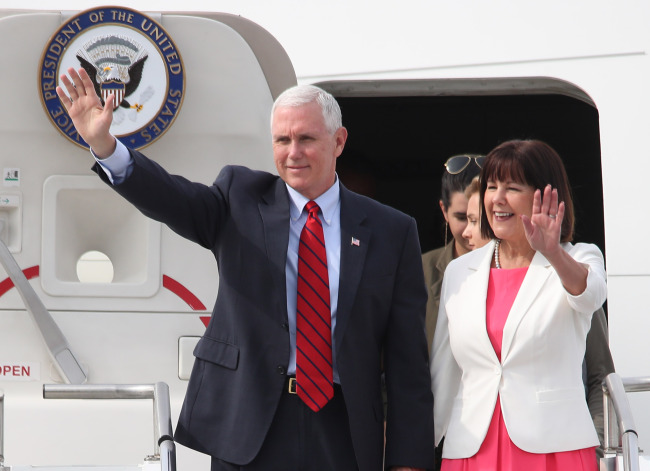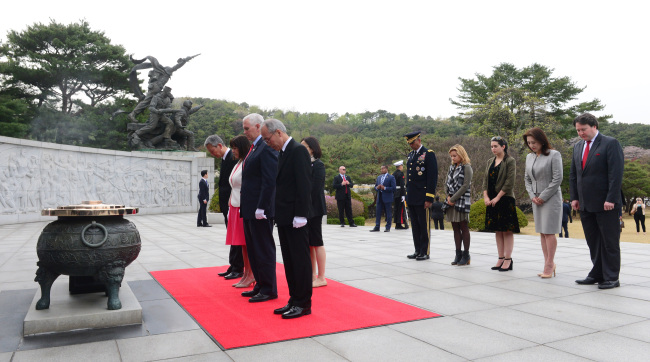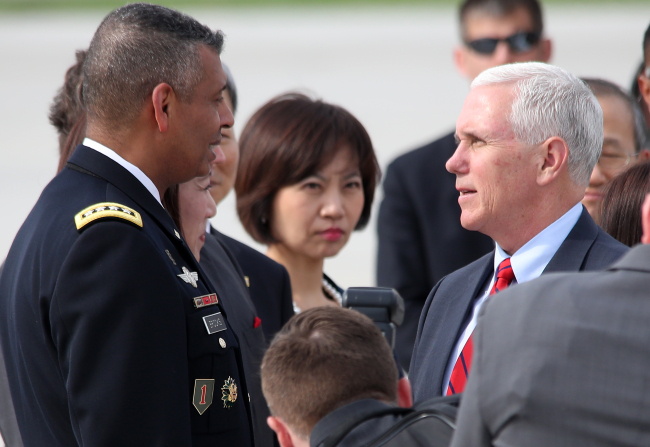US vice president arrives at Seoul amid heightened tension
THAAD deployment up to the next South Korean president, White House says
By Yeo Jun-sukPublished : April 16, 2017 - 18:33
US Vice President Mike Pence arrived in Seoul on Sunday for a three-day visit aimed at further enhancing bilateral alliance against the growing military threat from North Korea, which carried out a failed missile test just hours before the arrival.
The vice president will meet with Seoul’s acting President and Prime Minister Hwang Kyo-ahn on Monday afternoon to reinforce the US commitment to the alliance and to consult with South Korea over North Korea’s ballistic missile and nuclear programs.
The two leaders are also expected to discuss whether the allies will deploy a US advanced anti-missile battery promptly. A White House foreign adviser told reporters Sunday that the deployment of the Terminal High Altitude Area defense system would be “a decision for the next South Korean president.”
The vice president will meet with Seoul’s acting President and Prime Minister Hwang Kyo-ahn on Monday afternoon to reinforce the US commitment to the alliance and to consult with South Korea over North Korea’s ballistic missile and nuclear programs.
The two leaders are also expected to discuss whether the allies will deploy a US advanced anti-missile battery promptly. A White House foreign adviser told reporters Sunday that the deployment of the Terminal High Altitude Area defense system would be “a decision for the next South Korean president.”

Pence’s visit to Seoul is part of his 10-day trip to the Asia-Pacific region designed to lay out the administration’s policies for the region, including whether the US would seek a “military option” against the belligerent North.
Despite heated rhetoric about a potential military conflict, US President Donald Trump has lately adopted an official policy against the North to impose “maximum pressure and engagement” by toughening up economic sanctions with the help of China.
After touching down at the US Osan Airbase south of Seoul, Pence paid a visit to Seoul National Cemetery and placed a wreath during a brief ceremony. He will join US and South Korean troops for Easter Sunday church services and a dinner later in the day.
About nine hours before his visit, the North carried out a missile test, which ended in failure as the missile exploded in midair. The missile lifted off from a land-based facility near its eastern coast city of Sinpo, where it carried out a similar ballistic missile test on April 5, according to South Korea’s military.

“The missile blew up almost immediately,” said Cmdr. Dave Benham, a spokesman for the United States Pacific Command, adding that they detected and tracked the missile at 6:21 a.m. and that assessment is underway to determine the type of the missile.
South Korea’s joint chiefs of staff also said the test appeared to be a “failure” and that further analysis is needed to determine the missile’s type and its flight range. A separate intelligence source said the missile was assessed to have not flown far from its land-based launch site.
The vice president was notified about the missile launch and reported it to US President Donald Trump before the plane arrived in South Korea, said a White House official. The president made “no further comments,” according to the statement released by US Defense Secretary Jim Mattis
Military analysts noted that the exploded missile appeared not to be an intercontinental ballistic missile, whose new and modified version was unveiled Saturday during the military parade to mark the 105th birthday of the North’s founder Kim Il-sung.
The communist regime revealed a newly modified intercontinental ballistic missile and two types of large launchers with never-before-seen missile canisters, fueling concerns about the speed at which Pyongyang’s missile program has advanced in recent years.
The South Korean military said the two launchers might have contained a new version of ICBMs, which could be longer than the KN-08 and KN-14. Some analysts said the modified ICBM appeared to have elements of the KN-08, calling it a “frankenmissile.”

Sunday’s missile launch was the latest of the North’s botched missile tests, which analysists saw as an attempt to mater technology needed to develop an ICBM capable of hitting the US. Out of the five tests Pyongyang conducted this year, three have ended up in failure as the missiles exploded in mid-air.
Seoul government strongly condemned the launch, warning that Pyongyang would be subject to “unbearably strong punitive measure,” should the regime proceed with “high-intensity” provocations such as a sixth nuclear test or ICBM launch.
Shortly after the missile launch, Cheong Wa Dae convened a National Security Council meeting chaired by its chief Kim Kwan-jin. Those who attended pledged a stern response against North Korea’s potential military provocation.
By Yeo Jun-suk (jasonyeo@heraldcorp.com)











![[Today’s K-pop] BTS pop-up event to come to Seoul](http://res.heraldm.com/phpwas/restmb_idxmake.php?idx=644&simg=/content/image/2024/04/17/20240417050734_0.jpg&u=)




![[KH Explains] Hyundai's full hybrid edge to pay off amid slow transition to pure EVs](http://res.heraldm.com/phpwas/restmb_idxmake.php?idx=652&simg=/content/image/2024/04/18/20240418050645_0.jpg&u=20240419100350)

